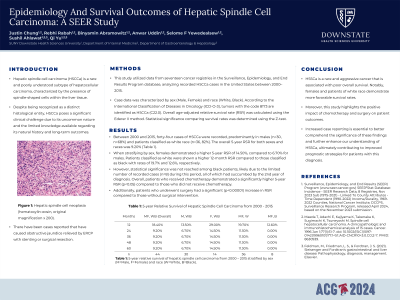Tuesday Poster Session
Category: Liver
P4679 - Epidemiology and Survival Outcomes of Hepatic Spindle Cell Carcinoma: A SEER Study
Tuesday, October 29, 2024
10:30 AM - 4:00 PM ET
Location: Exhibit Hall E

Has Audio

Justin Chung, MD
SUNY Downstate Health Sciences University
Brooklyn, NY
Presenting Author(s)
Justin Chung, MD1, Rebhi Rabah, MD1, Binyamin R. Abramowitz, MD2, Anwar Uddin, MD3, Selome F. Yewedalsew, MD1, Qi Yu, MD, MPH3, Sushil Ahlawat, MD, MS, MBBS1
1SUNY Downstate Health Sciences University, Brooklyn, NY; 2SUNY Downstate Health Sciences University, New York, NY; 3SUNY Downstate Medical Center, Brooklyn, NY
Introduction: Hepatic spindle cell carcinoma (HSCCa) is a rare and poorly understood subtype of hepatocellular carcinoma, characterized by the presence of spindle-shaped cells within the liver tissue. Despite being recognized as a distinct histological entity, HSCCa poses a significant clinical challenge due to its uncommon nature and the limited knowledge available regarding its natural history and long-term outcomes.
Methods: This study utilized data from seventeen cancer registries in the Surveillance, Epidemiology, and End Results Program database, analyzing recorded HSCCa cases in the United States between 2000–2015. Case data was characterized by sex (Male, Female) and race (White, Black). According to the International Classification of Diseases in Oncology (ICD-O-3), tumors with the code 8173 are identified as HSCCa (C22.0). Overall age-adjusted relative survival rate (RSR) was calculated using the Ederer II method. Statistical significance comparing survival rates was determined using the Z-test.
Results: Between 2000 and 2015, forty-four cases of HSCCa were recorded, predominantly in males (n=30, n=68%) and patients classified as White race (n=36, 82%). The overall 5-year RSR for both sexes and races was 9.20%. When stratifying by sex, females demonstrated a higher 5-year RSR of 14.50%, compared to 6.70% for males. Patients classified as White were showed a higher 12-month RSR compared to those classified as Black with rates of 19.7% and 12.6%, respectively. However, statistical significance was not reached among Black patients, likely due to the limited number of recorded cases (n=8) during this period, all of which had succumbed by the 2nd year of diagnosis. Overall, patients who received chemotherapy demonstrated a significantly higher 5-year RSR (p< 0.05) compared to those who did not receive chemotherapy. Additionally, patients who underwent surgery had a significant (p< 0.00001) increase in RSR compared to those without surgical intervention.
Discussion: HSSCa is a rare and aggressive cancer that is associated with poor overall survival. Notably, Females and patients of White race demonstrate more favorable survival rates. Moreover, this study highlights the positive impact of chemotherapy and surgery on patient outcomes. Increased case reporting is essential to better comprehend the significance of these findings and further enhance our understanding of HSSCa, ultimately contributing to improved prognostic strategies for patients with this diagnosis.
Note: The table for this abstract can be viewed in the ePoster Gallery section of the ACG 2024 ePoster Site or in The American Journal of Gastroenterology's abstract supplement issue, both of which will be available starting October 27, 2024.
Disclosures:
Justin Chung, MD1, Rebhi Rabah, MD1, Binyamin R. Abramowitz, MD2, Anwar Uddin, MD3, Selome F. Yewedalsew, MD1, Qi Yu, MD, MPH3, Sushil Ahlawat, MD, MS, MBBS1. P4679 - Epidemiology and Survival Outcomes of Hepatic Spindle Cell Carcinoma: A SEER Study, ACG 2024 Annual Scientific Meeting Abstracts. Philadelphia, PA: American College of Gastroenterology.
1SUNY Downstate Health Sciences University, Brooklyn, NY; 2SUNY Downstate Health Sciences University, New York, NY; 3SUNY Downstate Medical Center, Brooklyn, NY
Introduction: Hepatic spindle cell carcinoma (HSCCa) is a rare and poorly understood subtype of hepatocellular carcinoma, characterized by the presence of spindle-shaped cells within the liver tissue. Despite being recognized as a distinct histological entity, HSCCa poses a significant clinical challenge due to its uncommon nature and the limited knowledge available regarding its natural history and long-term outcomes.
Methods: This study utilized data from seventeen cancer registries in the Surveillance, Epidemiology, and End Results Program database, analyzing recorded HSCCa cases in the United States between 2000–2015. Case data was characterized by sex (Male, Female) and race (White, Black). According to the International Classification of Diseases in Oncology (ICD-O-3), tumors with the code 8173 are identified as HSCCa (C22.0). Overall age-adjusted relative survival rate (RSR) was calculated using the Ederer II method. Statistical significance comparing survival rates was determined using the Z-test.
Results: Between 2000 and 2015, forty-four cases of HSCCa were recorded, predominantly in males (n=30, n=68%) and patients classified as White race (n=36, 82%). The overall 5-year RSR for both sexes and races was 9.20%. When stratifying by sex, females demonstrated a higher 5-year RSR of 14.50%, compared to 6.70% for males. Patients classified as White were showed a higher 12-month RSR compared to those classified as Black with rates of 19.7% and 12.6%, respectively. However, statistical significance was not reached among Black patients, likely due to the limited number of recorded cases (n=8) during this period, all of which had succumbed by the 2nd year of diagnosis. Overall, patients who received chemotherapy demonstrated a significantly higher 5-year RSR (p< 0.05) compared to those who did not receive chemotherapy. Additionally, patients who underwent surgery had a significant (p< 0.00001) increase in RSR compared to those without surgical intervention.
Discussion: HSSCa is a rare and aggressive cancer that is associated with poor overall survival. Notably, Females and patients of White race demonstrate more favorable survival rates. Moreover, this study highlights the positive impact of chemotherapy and surgery on patient outcomes. Increased case reporting is essential to better comprehend the significance of these findings and further enhance our understanding of HSSCa, ultimately contributing to improved prognostic strategies for patients with this diagnosis.
Note: The table for this abstract can be viewed in the ePoster Gallery section of the ACG 2024 ePoster Site or in The American Journal of Gastroenterology's abstract supplement issue, both of which will be available starting October 27, 2024.
Disclosures:
Justin Chung indicated no relevant financial relationships.
Rebhi Rabah indicated no relevant financial relationships.
Binyamin Abramowitz indicated no relevant financial relationships.
Anwar Uddin indicated no relevant financial relationships.
Selome Yewedalsew indicated no relevant financial relationships.
Qi Yu indicated no relevant financial relationships.
Sushil Ahlawat indicated no relevant financial relationships.
Justin Chung, MD1, Rebhi Rabah, MD1, Binyamin R. Abramowitz, MD2, Anwar Uddin, MD3, Selome F. Yewedalsew, MD1, Qi Yu, MD, MPH3, Sushil Ahlawat, MD, MS, MBBS1. P4679 - Epidemiology and Survival Outcomes of Hepatic Spindle Cell Carcinoma: A SEER Study, ACG 2024 Annual Scientific Meeting Abstracts. Philadelphia, PA: American College of Gastroenterology.
